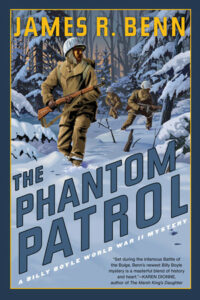Billy Boyle #19
 War is hell. In his gentle, narrative manner, James R. Benn has demonstrated through 19 and counting Billy Boyle novels this harsh verity. All of them, in their own way, are excellent, some of them more traditionally structured mysteries, like the locked room puzzler The Red Horse (2020) or the English village set Proud Sorrows (2023). But they all take place during WWII and feature at least one bravura battle or action scene. Book 19 is set during the Battle of the Bulge, and even though hostilities would end several months later, Billy finds himself still in the thick of things.
War is hell. In his gentle, narrative manner, James R. Benn has demonstrated through 19 and counting Billy Boyle novels this harsh verity. All of them, in their own way, are excellent, some of them more traditionally structured mysteries, like the locked room puzzler The Red Horse (2020) or the English village set Proud Sorrows (2023). But they all take place during WWII and feature at least one bravura battle or action scene. Book 19 is set during the Battle of the Bulge, and even though hostilities would end several months later, Billy finds himself still in the thick of things.
Billy, a former cop, works for General Eisenhower (a cousin, though he calls him “Uncle Ike”) as an investigator. This novel kicks off with the discovery of Klimt drawing which was obviously looted by the Germans. The thread he follows in order to find the original owner illuminates the work of the real life Rose Valland, a woman who kept track of looted art and was able to ultimately return 60,000 works. In the novel, she validates the value and authenticity of the Klimt drawing.
Much of the story then focuses on the group – we might think of them as a sleeper cell – who stole the drawing and seem as though they could be disrupting the allies in other, more dangerous ways, one of them a rumored attack on First Army headquarters. The journey Billy takes (mostly solo) through the French countryside illustrates the confusion of the soldiers on the front as the Battle of the Bulge was going on. In the midst of the chaos nothing seemed to make sense.
In pursuit of his objective he finds himself trudging through snow, surviving a plane crash, hiding in the woods, throwing grenades, setting off bombs, and in more than one encounter, fighting for his life. In constant danger, exhausted and often hungry, he still must use his brain to piece together what’s happening in the topsy-turvy world around him. Benn’s novels always give the reader an appreciation for what the soldier on the ground experienced and though Billy is slightly elevated and has more access than a common soldier, his experiences are as challenging and dangerous as theirs.
Benn also presents a magnificent set piece in each novel, and, happily, this one has two. In the first, Billy and a pilot get aboard a tiny plane (which at that time were basically frames covered with canvas) on a low visibility day. Their terrors are recounted in a way that makes it only too easy for the reader to feel they are along for the white knuckle ride. The other is a sequence toward the end of the novel which I won’t reveal too much of here, but suffice it to say, it’s a wowser of an ending for the novel.
While I enjoyed much of this book I found myself wishing there was a bit more about the work of the Monuments Men, who recovered stolen artwork. Much of Billy’s on the ground machinations in and around the front were, to me, slightly confusing. I even re-watched Patton to get a feel for the Battle of the Bulge, but of course that story is told from the point of view of a general and not a soldier. However, I always learn something when I read a Benn novel, and am always delighted to reunite with Billy, who is a wonderful, dare I say already classic, character. — Robin Agnew